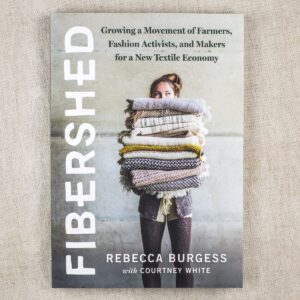SDA Book Club: “Fibershed” reviewed by Faith Hagenhofer
September 25, 2020
Faith Hagenhofer returns again this month for another installment of SDA’s Book Club. September’s book is Fibershed by Rebecca Burgess (with Courtney White), which focuses on “a new ‘farm-to-closet’ vision for the clothes we wear–by a leader in the movement for local textile economies.” We hope you enjoy!
Fibershed: Growing a Movement of Farmers, Fashion Activists, and Makers for a New Textile Economy by Rebecca Burgess with Courtney White

I’m grateful that Rebecca Burgess has shone a bright light on the hornet’s nest of problems of global textiles and their supply chains, most thoroughly addressing the issues in fiber farming, and imagined some possible solutions in her book Fibershed. It paves the way for much follow-up work, wherein the challenges to place-based clothing systems can continue to be addressed, with scalable solutions to engage all of us. According to her, if we all dressed from our own fibershed we could achieve “place-based textile sovereignty.” To Burgess any fibershed would “focus on… connectivity among all the parts, from soil to skin and back to the soil”.
Burgess sets out to explore what experiencing her own fibershed means in practice, starting with an art experiment to clothe herself from her own fibershed, centered in California’s San Francisco Bay Area, for one year. This serves as the model and origin story. It unfolds into Burgess’ hopes and efforts to create a larger movement. After Burgess’ bucolic descriptions of her year of dressing “locally” she presents solid, excellently researched statistics and alarming information on our society’s current environmentally disastrous fiber industries, and our highly dissonant relationship to textile materials, and clothing in particular. This information is situated in the larger challenges of climate change and wealth inequality, particularly in labor. Burgess proposes a solution: a scalable system of regional regenerative agriculture, met by appropriate processing methods, all using fair labor, and a chastened consumer public. It is a fair outline of the requirements and responsibilities for each of the intersecting systems. Thus is born the concept of “fibersheds” and the organization which attempts to spread the word.
A fibershed would be delineated geographically by the sources of raw materials available and a transparency for the consumer in their conversions into clothing, through the myriad manufacture processes that conversion entails. From the raw materials producer’s point of view, access, not simply transparency, is paramount. Thus, I would argue that the capacity for access to all stages of the means of production and manufacture need to be available for the fiber farmer. Further, for a fibershed to gain traction as a value in clothing there would need to be a market and many people would need to have the economic capacity for access to the idea, and the brand, if you will.
I read this book as a small flock sheep farmer. The arguments for shifting farming practices to encompass carbon-farming regenerative agricultural methods, as a way to focus “Fibershed”, the organization, on climate, was very exciting, inspiring, and persuasive.
I lamented with her on the problems in small scale manufacture, but I had hoped for more details on this part of the fibershed solution, such as better access to mills. Unfortunately, her story mirrors my own experience with growing wool and getting it processed. The question of getting literal buy-in from consumers is also not well addressed, clearly an area where the fibershed movement has work to do. “We have little to no demand-side pull-through strategies that would engage farmers”, Burgess writes. She suggests that it could be addressed by “agreements between fashion brands and agricultural land managers”. Reading this I looked for and didn’t find an added critique of fashion magazines. Likewise, the discussion about impediments from trade policies and problematic tariffs was too brief. That said, this book on the work of the organization and the movement is important reading for the clothes-wearing public.
–Faith Hagenhofer, is a fiber artist, shepherd, retired librarian, and has been involved with Surface Design Association for more than a dozen years. She serves as the South Puget Sound (Washington, US) SDA contact.
- Publisher: Chelsea Green Publishing (buy it here)
- Date: November 2019
- ISBN: 9781603586634
If you’ve read this book, leave a comment and let us know what you think!
Do you have a recommendation for a recent fiber-related book you think should be included in SDA’s Book Club? Email SDA’s Managing Editor, Lauren Sinner, to let her know!


